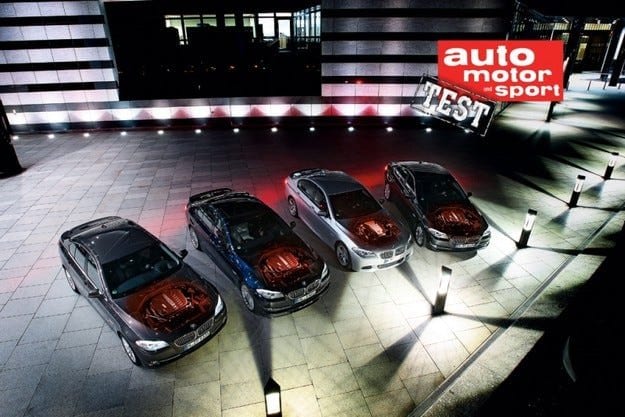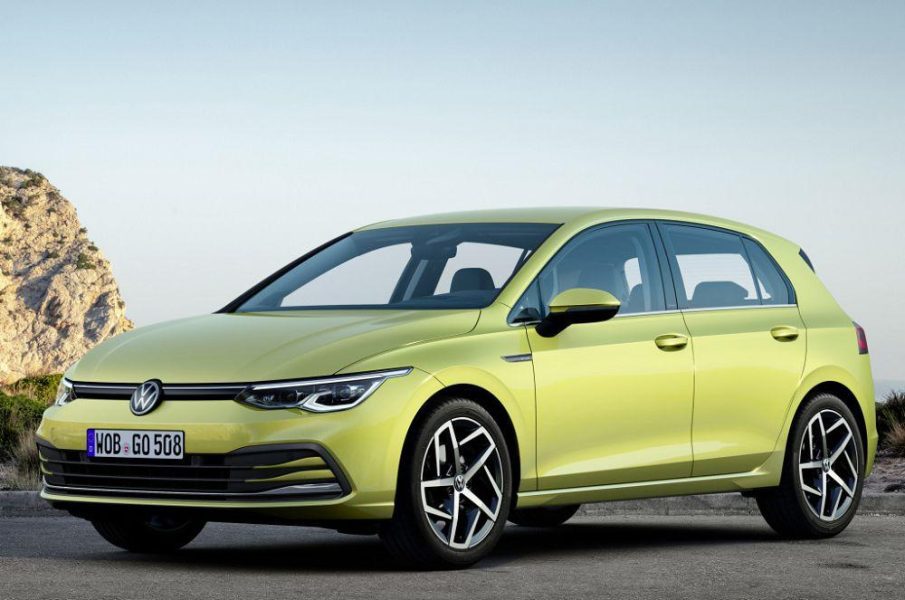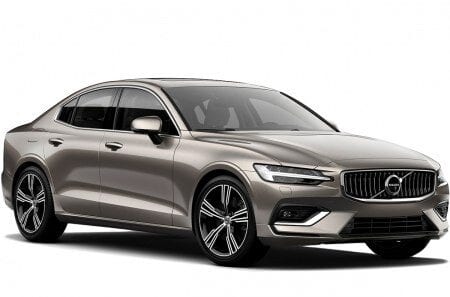
Test drive three-liter diesel engines BMW
Content

The BMW inline six-cylinder three-liter diesel engine is available with outputs from 258 to 381 hp. Alpina adds its 350 hp interpretation to this combination. Do you need to invest in powerful critters or act pragmatically with a more profitable base version?
Three-liter turbodiesel with four different power levels - at first glance, everything seems very clear. This is probably a purely electronic installation, and the differences are only in the field of microprocessor control. Not really! This is not so, if only because we are talking about various technological solutions in the field of turbocharging systems. And of course, not only in them. In this case, a number of questions naturally arise: isn't the 530d the best choice? Or is the 535d not the best combination of quality and price? Why not focus on the complex and powerful but expensive Alpina D5 from Buchloe or directly on Munich's flagship M550d?
Apart from the difference in power and torque, we must add to the accounts the difference of 67 leva between the most profitable and the most expensive model. 000d with 530 hp has a base price of 258 96 leva, 780 pence (535 hp) costs 313 15 leva more. This is followed by a very serious financial leap to the M 320d and its 550 leva, and in the Alpina price list we find an intermediate model with 163 hp. for 750 euros.
Factory solutions
Despite being the least powerful, the 530d variant with 560 Nm torque also offers a spontaneous jump in power, which is accompanied by a minimal delay in the gas flow response. This is not surprising, since the relatively large Garrett turbocharger has a variable geometry (VTG) in which special louver-like flow vanes are placed in the path of the exhaust gases. Depending on the gaps formed between them, which the electronics control depending on the load and speed, the flow is accelerated to a greater or lesser extent, providing a faster response of the turbine, despite its large size and power. Thus, spontaneous acceleration is combined with a relatively high compressed air pressure (1,8 bar).
Both the 530d and its superior sibling 535d have an aluminum crankcase. In the more powerful unit, the fuel injection pressure has been increased from 1800 to 2000 bar, and the charging system now consists of two turbochargers. At lower revs, the smaller turbocharger (with VTG variable geometry) fills the engine, while the fresh air it receives is still partially compressed by the larger one. Meanwhile, the bypass valve begins to open, allowing some of the gases to flow directly into the large turbocharger. After a transitional period, during which both units operate, the large one gradually takes over the filling task, eliminating the small one.
The maximum pressure in the system is 2,25 bar, the large compressor is actually of the low pressure type with its 2,15 bar, while the small unit, designed to create high pressure, has the task of supplying air for better response to low speeds and always receives pre-compressed air from a large compressor.
In theory, the 535d should respond faster than the 530d at full throttle and achieve faster torque ramps. However, measurements taken with auto motor und sport paint a slightly different picture. For starters to 80 km / h, the weaker engine accelerates faster (3,9 versus 4,0 seconds), but between 80 and 100 km / h, the 535d already activates full power and is well ahead of the 530d. Ultra-precise measurements with an acceleration of 1000 rpm in fifth gear show that initially a car with a weaker engine overtakes its more powerful brother and only after about 1,5 seconds the more powerful one reaches its speed (here we are talking about acceleration from 2 to 3 km / h) and overtakes it, using the potential of its maximum torque of 630 Nm.
Another point of view
The Alpina D5 sits in this narrow range between the two models, but overall the Buchloe has the best performance in terms of intermediate acceleration in tests. Why is this so? Alpina uses a 535d cascade engine, but the company's engineers have optimized the entire intake manifold to provide more air to fill the cylinders. The new system with an increased pipe diameter and an optimized radius of curvature reduces air flow resistance by 30 percent. Thus, the engine breathes more freely, and more air makes it possible to inject more diesel fuel and, of course, increase power.
Since the Alpina crankcase is not reinforced like the M 550d, the company's engineers increased the filling pressure by just 0,3 bar. This, together with other measures to increase power, nevertheless led to an increase in the exhaust gas temperature by 50 degrees, which is why the exhaust pipes are made of more heat-resistant D5S steel.
The turbocharger system itself remains unchanged. On the other hand, as already mentioned, the intake and exhaust tracts have been optimized and the intercooler size has been increased. The latter, however, retained the principle of air cooling and, in contrast to the complex water cooler M 550d, does not have to use a separate water circuit.
On the top
The Bavarian company's top diesel model is the only one available as standard with all-wheel drive, as well as a unique refueling technology with three turbochargers. Shortly after idling, the small turbocharger (VTG) takes over and the large one (no VTG) delivers power at about 1500rpm, following the 535d's cascade principle - at about 2700rpm, a bypass valve that diverts some of the gases to the large turbocharger . The difference from the two-block system is that a third, again small, turbocharger is built into this bypass line.
The data on this engine speaks for itself - 381 hp. staying at this level from 4000 to 4400 rpm means a liter of 127 hp. 740 Nm of torque provide excellent traction, and the rev mode reaches 5400 rpm, moving into the normal modes of a gasoline engine. No other diesel engine has such a wide operating range while maintaining a high level of traction.
The reasons for this lie in the huge technological base of this engine - not only the crankcase, crankshaft and connecting rods have been strengthened, which must withstand increased operating pressure from 535 to 185 bar compared to 200d. The fuel injection pressure has also been increased to 2200 bar and a sophisticated water circulation system cools the compressed air. All this results in unique performance in terms of dynamic parameters - the M 550d accelerates from standstill to 100 km / h in five seconds and in another 15,1 to 200 km / h. However, the creation of Alpina is not far behind, showing that with careful refinement a two-unit cascade system also has more potential. Of course, in terms of pure data, the Alpina D5 lags behind the M 550d, but its engine has to handle less weight (120 kg) - a fact that explains the extremely close acceleration.
Real comparison
Likewise, we are talking about a slightly less powerful, but significantly cheaper 535d that hits 200 km/h in almost the same time as its domestic rivals. Even greater differences can be found in the reaction of the car. Throttle retardation, which is usually interpreted as a turbo hole, is highest on the 535d and lowest on the M 550d. Significant technical improvements have affected here - but there is no other such technology in the world.
However, other interesting facts also emerge - when accelerating to 80 km / h, the 530d overtakes a more powerful one with 50 hp. 535d. The latter then regains leadership, but with an average fuel consumption it reports more per liter. The Alpina is king in terms of elasticity - the rapid increase in torque and light weight compared to the M 550d give it a significant advantage.
If you take a look at the road performance data, you'll find that even compared to its powerful counterparts, the 530d isn't that bad. Its performance in terms of intermediate acceleration is lower, but this is quite understandable, given the longer main transmission, which, however, gives it an advantage in fuel consumption when driving at high speeds. However, this setting does not become a dynamic problem, because in the event of a sudden opening of the throttle, the ideal eight-speed transmission reacts quickly enough and allows for dynamic acceleration. Just a few years ago, with its 258 hp. The 530d could be the flagship of the diesel lineup. However, this version is now on top of another indicator - as our recommendation in this comparison.
text: Marcus peters
technical details
| Alpina D5 BiTurbo | BMW 530d | BMW 535d | BMW M550d xDrive | |
|---|---|---|---|---|
| Working volume | - | - | - | - |
| Power | 350 k.s. at 4000 rpm | 258 k.s. at 4000 rpm | 313 k.s. at 4400 rpm | 381 k.s. at 4000 rpm |
| Maximum torque | - | - | - | - |
| Acceleration 0-100 km / h | 5,2 with | 5,9 with | 5,6 with | 5,0 with |
| Braking distances at a speed of 100 km / h | - | - | - | - |
| full speed | 275 km / h | 250 km / h | 250 km / h | 250 km / h |
| Average consumption fuel in the test | 10,3 l | 8,3 l | 9,4 l | 11,2 l |
| Base Price | 70 950 euro | 96 780 levov | 112 100 levov | 163 750 levov |

